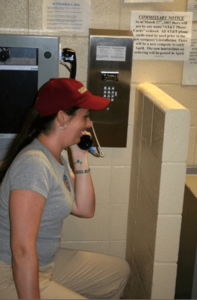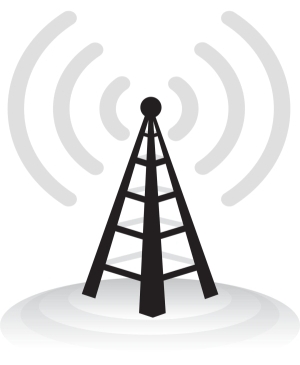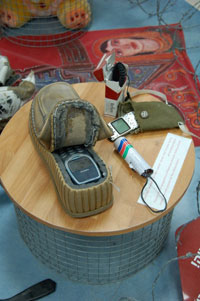 This is a great article discussing the value and need for more communication between prison detainees in order to reduce recidivism. As the article states, “Phone calls can mean the difference between maintaining relationships that make leading a healthy life outside of prison or falling into a cycle of moving in and out of prison.” High cost is part of the reason for the epidemic of contraband cell phones being smuggled into prisons everywhere.
This is a great article discussing the value and need for more communication between prison detainees in order to reduce recidivism. As the article states, “Phone calls can mean the difference between maintaining relationships that make leading a healthy life outside of prison or falling into a cycle of moving in and out of prison.” High cost is part of the reason for the epidemic of contraband cell phones being smuggled into prisons everywhere.
There are multiple reasons why families and prisoners are unable to stay connected, including the reason discussed in this article – the high cost of phone calls from prisons and jails. However, there are other reasons that we feel can be addressed by the unique meshDETECT secure cell phone solution.
For instance, there are a limited number of payphones in each prison facility. As one wife of a prisoner in a federal prison told us, “The lines that an inmate has to wait in to make a call are at least an hour long (during prime phone time). Often, this breeds heightened emotions and “combative” type situations for inmates. For example: if one guy is taking too long on his call and someone makes a rude comment/remark it can easily start a fight. I hear about it often. My husband and I will usually cut our conversations short out of respect for other inmates behind him in line.” Not only does this limit the amount of time on the phone, and risk prisoner and correctional officer safety, the quality of the calls is impacted. Prisoners and their loved ones would like the privacy (not secrecy) to allow them to speak of health, personal and private matters when communicating.
Especially for those families that are unable to visit their incarcerated loved one due to distance or other circumstances, the prison payphone system is a lifeline for all involved. Our goal is to strengthen and enhance that lifeline while providing the prisons the security and control necessary to prevent improper use of the cell phone. In this way, we are reducing the demand for contraband cell phones and aiding prisoner rehabilitation.
Chris Duran understands the value of a phone call. Duran pays roughly $2.80 for a 15-minute phone call to talk with her partner who is incarcerated at a detention center in Albuquerque, New Mexico. That same call in Colorado would be $5.00, the difference is attributed to the unregulated prison phone rate system. Phone companies will often include high commissions to state prisons within contracts in exchange for being the exclusive service provider. The rate of these commissions inflates the cost of phone calls for families in states that have failed to regulate this practice.
Many times expensive phone calls create a barrier between a prisoner and their family’s ability to stay connected and provide crucial support for loved ones. Luckily for Duran, she and her partner live in one of the eight reformed states that have ended the practice of commissions. New Mexico’s rates are relatively low; prisoners are charged roughly$.20 a minute to talk with loved ones. “The only way that our family stays together and stands out is that she has someone to call on the outs who loves her,” said Duran in a video recorded last year by the Media Literacy Project in Albuquerque, New Mexico. “Really that’s the only way we have to stay in contact, through the PCS phone system.” For Duran’s partner and others behind bars, phone calls can mean the difference between maintaining relationships that make leading a healthy life outside of prison or falling into a cycle of moving in and out of prison.
Research suggests that prisoners who maintain contact with family or friends fare better upon release than those who do not maintain contact. A 2005 report by the Anne E. Casey Foundation found that families are a person’s first and last resort for housing and support when released from prison. The prison system considers a prisoner’s return home to their parents, children, partner or other family members to be the primary reentry plan upon release. It’s crucial that prisoners maintain connections with loved ones for support and to adequately prepare for reentry into their communities upon release. Whether or not a system ensures that prisoners are adequately prepared for reentry has an impact on whether or not they will return to the system.
The average U.S. recidivism rate lingers around 40 percent. According to a survey conducted by Pew and the Associate of State Correctional Administrators, 43 percent of released prisoners in 2004 were re-incarcerated within 3 years for new offenses or parole violations. Between 1973 and 2009, the nation’s prison population grew by 705 percent, resulting in more than 10 percent of adults behind bars.
Not only do high incarceration and recidivism rates affect families, they also affect taxpayers whose taxes fund a portion of state prison budgets, according to the Vera Institute of Justice. Annual state and federal spending on corrections exploded by 305 percent, or 52 billion people, during the past two decades. During that same period, corrections spending doubled as a share of state funding and accounts for 1 in 14 general state fund dollars, according to the Pew Center on the States.
These astonishing trends incited various prison justice advocacy efforts and drew the attention of conservative lawmakers whose shrinking budgets have caused them to re-evaluate how correction dollars are spent. For example, South Carolina’s prison population tripled over 25 years and was projected to grow by more than 3,200 inmates by 2014. Conservative groups like Right on Crime, a partnership between the Texas Public Policy Foundation and Pat Nolan Prison Fellowship,worked on passing a prison reform package along with former Speaker of the House Newt Gingrich. The initiative ultimately gained the support of justice advocacy groups like the ACLU.
Prison reform advocates recognized that over half of the state’s population was incarcerated for nonviolent crimes. They found that the state could save $350 million by adjusting sentences for nonviolent offenses and targeting barriers prisoners face upon release. Within the past years, all 19 states that cut their imprisonment rates also experienced a decline in their crime rates, according to the Pew Center. It’s clear that a dollar invested in rehabilitation yields a greater return by keeping released prisoners out of the system and reducing the correction costs for states over time.
Congress also targeted this country’s high recidivism rate by passing the Second Chance Act in 2008. This piece of legislation authorizes government funds for nonprofits and agencies that would improve the conditions facing prisoners upon their release. These programs use resources for housing, employment, substance abuse treatment, continuing education and family programming. Reducing recidivism saves taxpayer dollars in the long run and reduces prison populations which would alleviate a prison system’s dependence on funds collected from commissions.
A policy reform that should be addressed by both states and the FCC is ensuring that prisoners can stay connected with the loved ones by keeping phone costs low. Other states can follow the lead of the eight reformed states and outlaw the practice of commissions. The FCC can also regulate interstate phone rates which would lower the costs for families, enabling them to stay better connected. “Throughout the time I was in the system I had a really strong support system with my family,” said Duran. “The only way I could stay in contact with my family was through the phone.” She was released in 2002 and has been able to stay out of the detention system.
Author: Leticia Miranda, Clarissa Ramon
Source
- Multi-Blockchain System for Inmate Forensics - April 2, 2024
- Blockchain to Secure Attorney-Inmate Privacy for Prison Calls - June 28, 2023
- meshDETECT® Announces Grant of Ninth Patent For Blockchain Wireless Services - August 26, 2022




